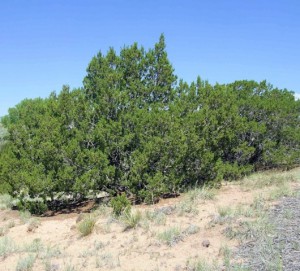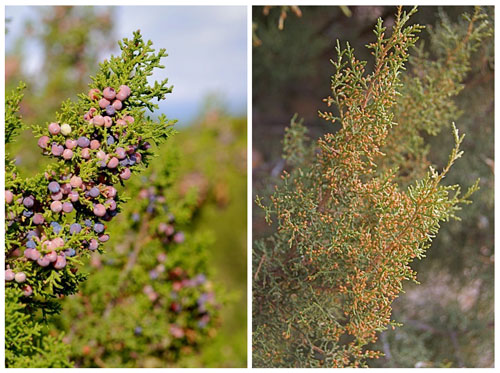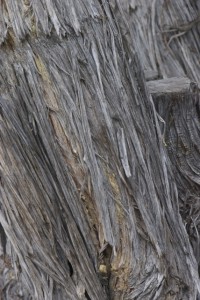Scientific name: Juniperus monosperma
Family: Cupressaceae – Cypress
Common name: One-seed juniper, New Mexico cedar, Cherrystone juniper, Sabina
By Susan Bruneni
Photos Courtesy of Janice Tucker

One-seeded Juniper (Photo: Janice Tucker)
The Juniperus monosperma, or One-seed juniper, dots the drier habitats of New Mexico between 5000 and 7000 feet. This slow-growing, drought-hardy native species is a remarkable example of a plant adapted to flourish during long dry periods in its local environment. The dry uplands at Leonora Curtin Wetland Preserve , elevations below the Ortiz Mountains Educational Preserve and the Museum Hill site are classic examples of this familiar Santa Fe terrain.
The US Forest Service estimates that one-quarter of New Mexico is covered with the One-seed juniper. It is native to New Mexico, Arizona, southern Colorado, western Oklahoma and western Texas, and the extreme north of Chihuahua in Mexico.
Above-ground growth is extremely slow, about six-inches per year in a season with normal precipitation. This year’s growth observation near Santa Fe is only about three inches. The One-seed juniper has the ability to stop active growth when moisture is limited but can resume growth when moisture availability improves.
While the juniper is slow-growing above ground, it is rapidly growing downward. A three-year-old plant (less than two-feet tall) can have a tap root 30 feet long. Mature plants range from 5 to 30 feet and can produce tap roots almost 200 feet long. The only other plant in the world with longer roots is the African tree, Boscia albitrunca. The One-seed juniper is an evergreen coniferous shrub or small tree, usually multistemmed, and with a dense, rounded crown. The bark is gray-brown, exfoliating in thin longitudinal strips.

One-seed juniper female "berries" (left) and male cones (right)
One-seed junipers are dioecious — male and female plants are separate. The male produces masses of tiny cones (see photo). Male plants will appear more yellowish-brown than the females. Pollination begins in late winter, with April winds forcing an explosion of the white, smoke-like pollen into the air. The females produce berry-like seed cones that mature in five months to a bluish purplish shade (see photo). The “berry” typically contains only one seed (monosperma). Young plants have needle-like foliage, changing to scaly on mature plants.
The dense base provides shelter for desert cotton-tails and birds. The berries provide food for a variety of animals, especially coyotes and scrub jays. Berries were a food source for Ancestral Puebloans when other food was scarce.
Because of its long tap root, the one-seed juniper is very difficult to transplant. However, local nurseries stock a variety of non-native juniper species, ranging from ground cover to varieties reaching 20 feet, suitable for wind-breaks and privacy hedges. “Non-native species will need routine care during the period when they establish themselves,” says Tim Berry of Newman’s Nursery of Santa Fe. “After that, they are also very drought-tolerant and do not produce the vast amounts of pollen associated with the one-seed juniper,” he said.
Leonora Curtin wrote extensively about the One-seed juniper in her book, Healing Herbs of the Upper Rio Grande. She noted: Juniper pitch was chewed instead of chewing gum, or ground with white beans and horehound to reduce facial swelling. Berries were widely used for a urinary tract disinfectant and diuretic purposes.

Juniper bark (Photo: Janice Tucker)
The bark made excellent kindling and tender. It was also made into a poultice to treat skin rashes. Branches were used in ceremonial purification after birth, and twigs were toasted and cooled, then bound over a sprain or bruise to reduce swelling. Tea made out of branches was extensively used to aid in childbirth, or reduce inflammation of the stomach.
Ashes are still used in preparing dyes for Navajo wools and as a key ingredient in many authentic Pueblo recipes (leaves are cleaned and burned, and ashes are kept in powdered form for uses in cooking). The plant is significant in traditional ceremonies and is worn or held. The leaves are burned to purify the air before a ceremony or blessing.
In the British Isles the berries of local species of juniper were burned to ward off witches, especially in late October to make certain no unwanted spirits would take up residence in a household. Junipers were planted outside the main door of a household to keep witches from entering the building.
The next time you roam through an arroyo, treasure your 300-400 year-old neighbors that continue to bring us a touch of green throughout the winter season. After a rainy night, make a point to face the sunrise standing west of a stand of One-seed junipers. The rising sun will bathe the branches in light and droplets will glow like a million tiny lights in a magical display.


